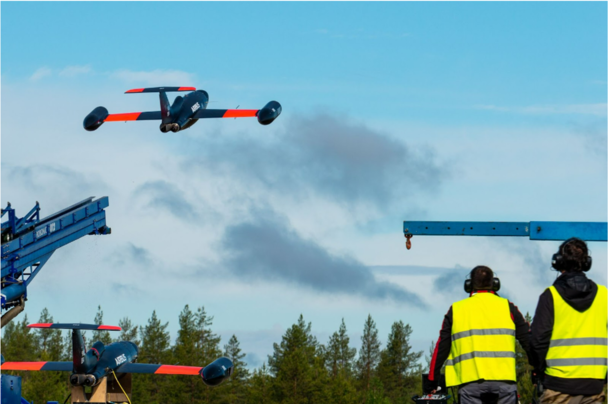European premiere: connected fighters, helicopter and drones accomplish demo mission

In Europe’s first large-scale manned-unmanned teaming flight demo, led by Airbus, two fighter jets, one helicopter and five unmanned remote carriers teamed up - and helped to rid the world of a fictional rogue warlord. This multi-domain flight demo paves the way towards the Future Combat Air System.
Everything has to happen fast now. Two allied fighter jets are deployed, and the success of the entire mission depends on them. For only if they take out the rogue warlord's ground based air defence can the special operations team fly in by helicopter, capture them and bring them before an international court.
The stakes are high, but the odds are in favour of the allied forces: the jet crews have strong support at their side - five drones, so-called remote carriers (RCs), flying ahead, penetrating enemy airspace and using their sensors to detect and mark ground air missile positions. The crews of the fighters then take out the hostile air defences - precisely and without any collateral damage.
First large-scale European manned-unmanned teaming demo
Sounds like science fiction? Not at all. Because a team of specialists from Airbus, the Bundeswehr, the Finnish Defence Forces and industry partners missile company MBDA Germany, networking data link provider Patria, autonomy and mission technology startup HAT.tec and drone launch system provider Robonic, did just that in the late summer of 2022. "With our Multi-Domain Flight Demo, or MDFD, we demonstrated for the first time in Europe how manned-unmanned teaming capabilities and functionalities with up to ten connected assets work in a real-life inspired scenario and under near operational conditions," explains Jean-Brice Dumont, Head of Military Air Systems at Airbus.
In the demo, a Learjet 35 from Airbus subsidiary GFD acted as a surrogate fighter, with the crew on board commanding the remote carriers, five modified Airbus Do-DT25 drones. Two of them were equipped with Electronic Support Measures (ESM) sensors from MBDA to detect the fictional rogue warlord’s ground air missile positions. The remaining three RCs were equipped with Electro Optical (EO) cameras that recorded and confirmed the locations of the air defences visually. All assets were connected by a networking data link from Patria. Additionally, one simulated fighter acting as a command and control aircraft was visible on the screens in the visitor tent where the contractor representatives from the German and Finnish armed forces followed the demo.

A Learjet 35 from Airbus subsidiary GFD acted as a surrogate fighter, with the crew on board commanding the remote carriers.
While the air defence was eliminated, ground troops requested close air support via a forward Joint Terminal Attack Controller (JTAC) to help them extract the fictional rogue warlord. An Airbus H145M helicopter responded immediately, helping the team to achieve their mission. In parallel, the H145M teamed up with one of the EO RCs keeping an eye on the surroundings and providing the special forces with reconnaissance data. The helicopter crew commanded the Do-DT25 directly from the cockpit while the video stream of the RC was directly transferred to the H145M. The JTAC, located close to the troops, co-ordinated the attack by digital emergency notification (9-liner request) to the helicopter and partly took over command and control of one EO RC to assess the success of the operation finally.
Vital asset of the Future Combat Air System
"The demonstration was an overwhelming success - the scenario went according to the plan, with the functionalities performing as intended," explains Airbus project manager Thomas Gottmann. The MDFD concluded the second phase of the so-called FCAS MUM-T (Future Combat Air System Manned-Unmanned-Teaming) Demonstrator project, funded by the German procurement agency BAAINBw. Now the project is going to enter Phase III, which will lead to maturing of existing capabilities and development of new ones to enable initial operations in the 2030s with existing combat aircraft and remote carriers developed by then. An initial contract for the go ahead has just been signed between Airbus and BAAINBw, as well as between MBDA and BAAINBw.
Remote carriers with different sizes and capabilities are vital assets of FCAS, where they will operate in a team with the manned New Generation Fighter and the Eurofighter, connected to a cyber-secured combat cloud network. Operating under the command of a manned fighter aircraft, RCs provide better protection for pilots while enhancing the operational envelope and the ability to act in risky situations. “Conducting such collaborative engagements will require high levels of autonomy with only little direct and indirect human control,” explains Gottman
“The MDFD is yet another example of how we push boundaries and pioneer technologies so that our customers can fulfill their missions: saving lives and ensuring a better future for us all”, adds Jean-Brice Dumont. In the demo, this definitely worked as the fictional rogue warlord is no longer a threat to the world.
Want to see the connected fighters, helicopter and drones in action? Then watch this video:
Multi Domain Flight Demo
MUM-T - Manned Unmanned Teaming: Connected fighters, helicopter and drones accomplish demo mission